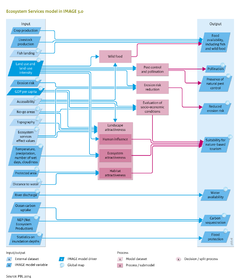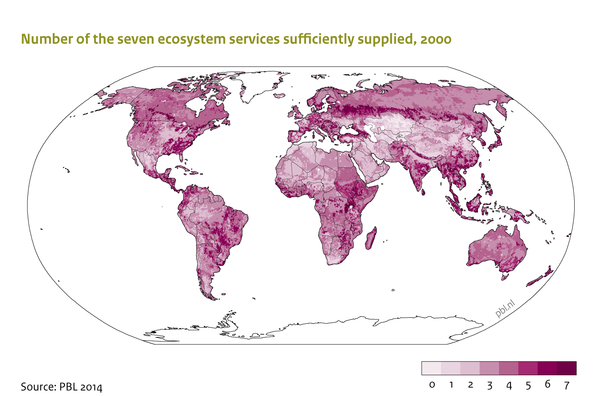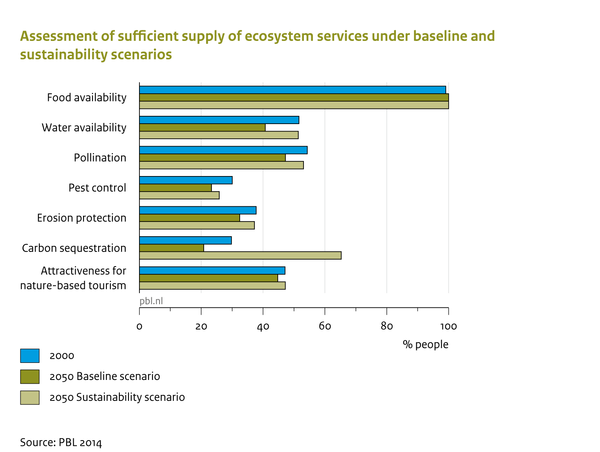Ecosystem services/Policy issues: Difference between revisions
No edit summary |
Oostenrijr (talk | contribs) No edit summary |
||
| (2 intermediate revisions by the same user not shown) | |||
| Line 1: | Line 1: | ||
{{ComponentPolicyIssueTemplate | {{ComponentPolicyIssueTemplate | ||
}} | |||
<div class="page_standard"> | |||
==Baseline developments== | |||
Around the world, the number of services (out of the seven services food, water, Carbon sequestration, erosion protection, pollination, pest control, flood protection, tourism) sufficiently supplied differs strongly (the figure below) | |||
In a baseline, the proportion of people living in regions with sufficient supply of an ecosystem service is decreasing for most services in the future, except for food (the figure Policy interventions below). According to the scenario, sufficient food will be produced regionally, but unequal food distribution will still lead to malnutrition and hunger. Areas with sufficient supplies of ‘pest control, ’pollination’ and ’erosion protection’ are likely to decrease. Availability of water per person and the amount of carbon sequestrated relative to the amount emitted also decreases. | |||
{{DisplayPolicyInterventionFigureTemplate|{{#titleparts: {{PAGENAME}}|1}}|Baseline figure}} | |||
==Policy interventions== | |||
As an example, the positive effect of one RIO+20 scenario (global technology scenario) on the sufficient delivery of most ecosystem services is presented in the figure below. The percentage of sufficient delivery increases compared to the baseline in 2050. The sustainability scenario focuses on limiting climate change, which is also illustrated by sufficient delivery of carbon sequestration. The sharp decline in water in the baseline 2050 is prevented in the global technology scenario. | |||
{{DisplayPolicyInterventionFigureTemplate|{{#titleparts: {{PAGENAME}}|1}}|Policy intervention figure}} | |||
{{PIEffectOnComponentTemplate }} | |||
}} | </div> | ||
Latest revision as of 15:50, 15 November 2018
Parts of Ecosystem services/Policy issues
| Component is implemented in: |
|
| Related IMAGE components |
| Projects/Applications |
| Key publications |
Baseline developments
Around the world, the number of services (out of the seven services food, water, Carbon sequestration, erosion protection, pollination, pest control, flood protection, tourism) sufficiently supplied differs strongly (the figure below)
In a baseline, the proportion of people living in regions with sufficient supply of an ecosystem service is decreasing for most services in the future, except for food (the figure Policy interventions below). According to the scenario, sufficient food will be produced regionally, but unequal food distribution will still lead to malnutrition and hunger. Areas with sufficient supplies of ‘pest control, ’pollination’ and ’erosion protection’ are likely to decrease. Availability of water per person and the amount of carbon sequestrated relative to the amount emitted also decreases.
Policy interventions
As an example, the positive effect of one RIO+20 scenario (global technology scenario) on the sufficient delivery of most ecosystem services is presented in the figure below. The percentage of sufficient delivery increases compared to the baseline in 2050. The sustainability scenario focuses on limiting climate change, which is also illustrated by sufficient delivery of carbon sequestration. The sharp decline in water in the baseline 2050 is prevented in the global technology scenario.
Effects of policy interventions on this component
| Policy intervention | Description | Effect |
|---|---|---|
| Agricultural trade policies | Changes in agricultural trade policies are applied to the corresponding quota (export or import quota) or border taxes. (Reference:: Verburg et al., 2009) |
Change in land use for agriculture, will also result in a change in nature and thereby influence the ES dependent on nature (e.g. erosion and flood protection, pest control and pollination).Large agricultural areas negatively influence the ES "nature based tourism", therefore change in agricultural land use will influence the ES "nature based tourism". |
| Changes in consumption and diet preferences | Interventions that target consumption changes or changes in dietary preferences (Reference:: Stehfest et al., 2013) |
Dietary changes reduces the amount of the ES "food" needed.When the reduced agricultural land use, results in an increase of natural area, the supply of the services dependent nature (e.g. erosion and flood protection, pollination and pest control), will be increased. |
| Changes in crop and livestock production systems | General changes in crop and livestock production systems, e.g. more efficient production methods to create higher production per unit of input, or other systems like organic farming | Increase intensity of the agricultural area, reduces nature on agricultural area thereby negatively influencing the ES dependent of nature (e.g. flood and erosion protection, pest control and pollination). While systems like organic farming contain more nature on agricultural areas and thereby positively influencing ES. |
| Enlarge protected areas | Increase in areas with protected status, as well the size of the areas as the numer of parks. (Reference:: PBL, 2010) | the ES "nature based tourism" is positively influenced by the amount of protected area. |
| Implementation of land use planning | Application of zoning laws or cadastres, assigning areas to certain land uses. | By implementing mosaic landscapes the supply of ES dependent of nature will increase (e.g. flood and erosion protection, pollination and pest control). |
| Increase natural carbon storage | It should be noted that policy measures to increase carbon storage often generate certain co-benefits, such as the restoration of watershed and wildlife habitats, and the prevention of soil erosion. | Increasing carbon storage will increase the supply of the ES "carbon sequestration" and "erosion prevention" |


